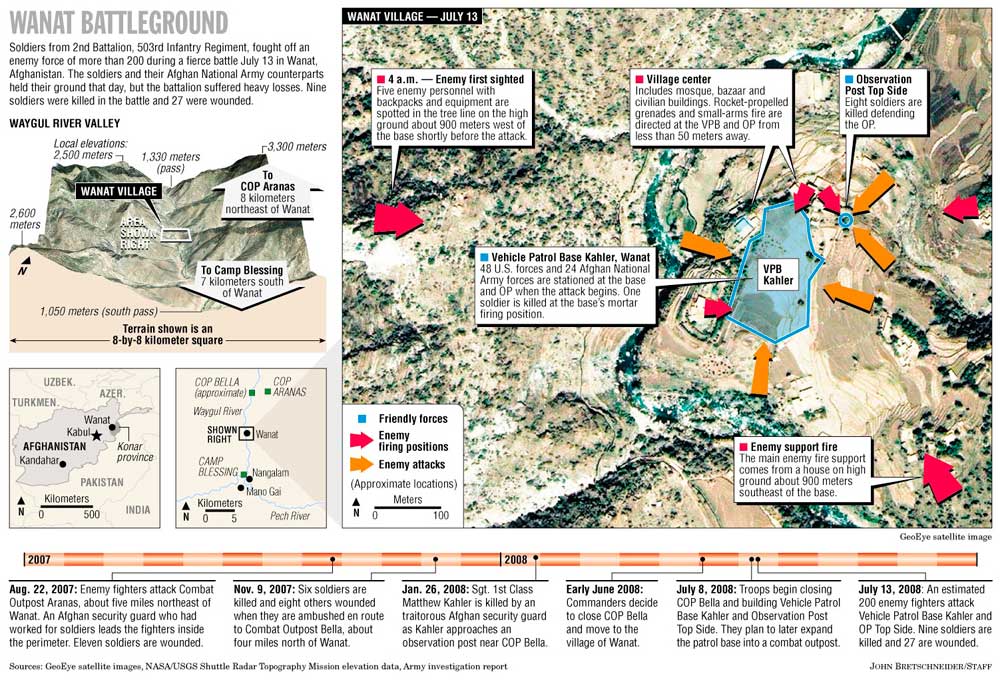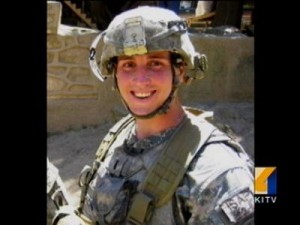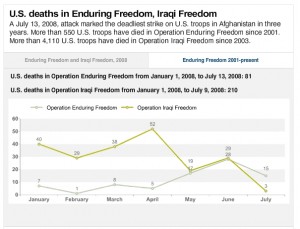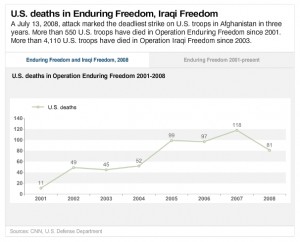Stars and Stripes summarizes the investigation into the battle of Wanat, and links a redacted version of the report: “AR 15-6 Investigation Findings and Recommendations – Vehicle Patrol Base (VPB) Wanat Complex Attack and Casualties,13 July 2008,” Part 1 and Part 2.
The AR 15-6 provides a fairly detailed analysis and event time line of the battle, and we learn quite a bit about the things that led up to the battle and the ensuing casualties. The report necessarily ends with findings and opinion concerning force protection among other things, and several observations of the battle and subject report are warranted.
The Waygul Valley and in particular the location of the Wanat VPB is in steep, rugged terrain, and location of any sort of combat outpost (or VPB) was risky from the standpoint of force protection, but the decision had been made approximately one year earlier to move COP (Combat Outpost) Bella to VPB Wanat due to the fertile human terrain for counterinsurgency.
The meetings with tribal and governmental officials to procure territory for VPB Wanat went on for about one year, and one elder privately said to U.S. Army officers that given the inherent appearance of tribal agreement with the outpost, it would be best if the Army simply constructed the base without interaction with the tribes. As it turns out, the protracted negotiations allowed AAF (anti-Afghan forces, in this case an acronym for Taliban, including some Tehrik-i-Taliban) to plan and stage a complex attack well in advance of turning the first shovel full of sand to fill HESCO barriers.
VPB Wanat did indeed have concertina wire, HESCO barriers and other means of force protection, but in every direction the base was on the low ground. One particularly fateful decision was the construction and garrisoning of Observation Post “Top Side,” which sat on slightly higher ground to the East of VPB Wanat.
Just before the battle began on July 12, 2008, troops from VPB Wanat observed men they believed to be enemy combatants positioning and preparing for battle, but consistent with a theme here at The Captain’s Journal, decision-making is not given latitude in these circumstances (e.g., no PID, not actively engaged in hostilities against U.S. troops at the time, or whatever the case – this portion of the report is redacted. See TCJ coverage of Rules of Engagement).
At 2350, AAF initiated a large scale attack on VPB Wanat and OP Top Side. The enemy numbering several hundred were located at the perimeter of the VPB and in surrounding buildings and from hillsides at elevated positions compared to VPB Wanat. The enemy engaged primarily with automatic weapons and RPGs.
OP Top Side was also under heavy attack by the enemy. In fact, of the 36 casualties suffered in this battle (nine dead, 27 wounded), nine were sustained in the first fifteen to twenty minutes of the attack, specifically at OP Top Side. The enemy were close enough to engage OP Top Side by throwing grenades and shooting automatic rifles from no more than twenty meters.
In response to calls for help, three waves were sent to reinforce OP Top Side. Of the first wave, two more U.S. soldiers died while attempting to set up a machine gun position. The second wave of reinforcements saw the twelfth, thirteenth, fourteenth and fifteenth U.S. casualties. Of these fifteen casualties, eight perished attempting to defend OP Top Side (out a total of nine dead in the totality of the battle of Wanat that night).
There were between 21 and 52 AAF killed and 45 wounded. Considering a clinical assessment of kill ratio can be a pointer to the level of risk associated with this VPB and OP. 21/9 = 2.33, 52/9 = 5.77 (2.33 – 5.77), and 45/27 = 1.67. These are very low compared to historical data (on the order of 10:1).
One bright spot in the battle concerns air support. Close Air Support (CAS) was initiated within 27 minutes of start of the battle, and Close Combat Aviation (CCA) was initiated within 62 minutes of start of the battle. Aircraft supporting U.S. troops includes B-1 bombers, F-15s, A-10s and AH-64 Apache Attack Helicopters. Multiple “gun runs” were conducted “danger close” to U.S. troops.
One key breakdown in force protection pertained to intelligence. Multiple villagers, including tribal elders, had told multiple U.S. troops that an attack on VPB Wanat was imminent, but the assumption that such an attack would be probative caused little concern among the leadership. But the enlisted ranks included men who knew what was coming. Cpl. Gunnar Zwilling suspected that his days were numbered, while he and his band of brothers in the 173rd Airborne Brigade Combat Team prepared for a mission near Wanat, Afghanistan. “It’s gonna be a bloodbath,” he told his father, Kurt Zwilling, on the phone in what would be their last conversation.
In fact, there had been daily reports of 200-300 fighters massing to attack COP Bella in the first 10 days of July before transfer of operations to VPB Wanat, and while U.S. forces anticipated a transfer of enemy activity to Wanat, they didn’t anticipate such heavy conventional operations. The AAF fielded a company-sized force to attack OP Top Side and VPB Wanat.
While we witnessed the adolescent fawning over Nir Rosen’s embedding with the Taliban (to which The Captain’s Journal was unimpressed and claimed that all of the information was already known without his having whored himself to the enemy), the real question is not why we haven’t listened to Nir Rosen. Rosen is irrelevant. The question is why U.S. intelligence would ignore reports directly from tribal elders in the town in which they wish to conduct COIN, thus losing nine sons of America.
There is also the issue of OP Top Side and whether such an Observation Post should have been garrisoned with so little force protection and such proximity and elevational vulnerabilities. Again, eight of the nine U.S. troops who perished that fateful night did so as a result of OP Top Side.
More broadly, the implementation of combat outposts (or VPB, or OP) should consider the modern day origins of such practice, i.e., the Marines in Anbar. COPs were “hopscotched” across Ramadi and other cities in Anbar (combined COP and police precincts in Fallujah), and while reinforcements were within minutes of each COP in Anbar, the first reinforcements arrived at VPB Wanat approximately two hours after start of the battle. While the terrain in Afghanistan is more rural, wide open and unfriendly to COPs located so closely together, still, the notion of a COP relies on reinforcements in close proximity.
Afghanistan is still an under-resourced campaign, as both Generals McNeill and McKiernan have told us. Counterinsurgency TTPs can only be implemented if the campaign is treated as COIN rather than counterterrorism operations against high value targets.
Finally, in the future, the Army would do well to consider the Marines in Helmand and their COIN tactics. Kinetic operations served as the basis for reconstruction efforts, and no Marine asked for permission to attack Garmser. More than 400 Taliban died as a result of Marine operations in Helmand. One year of planning to open an COP at Wanat is about 11.5 months wasted.
In summary, while the TTP of VPB Wanat and OP Top Side were questionable, and while Afghanistan is an underresourced campaign, the men who fought that fateful night were brave in the superlative. America should be justly proud of her sons who fought with such valor.







